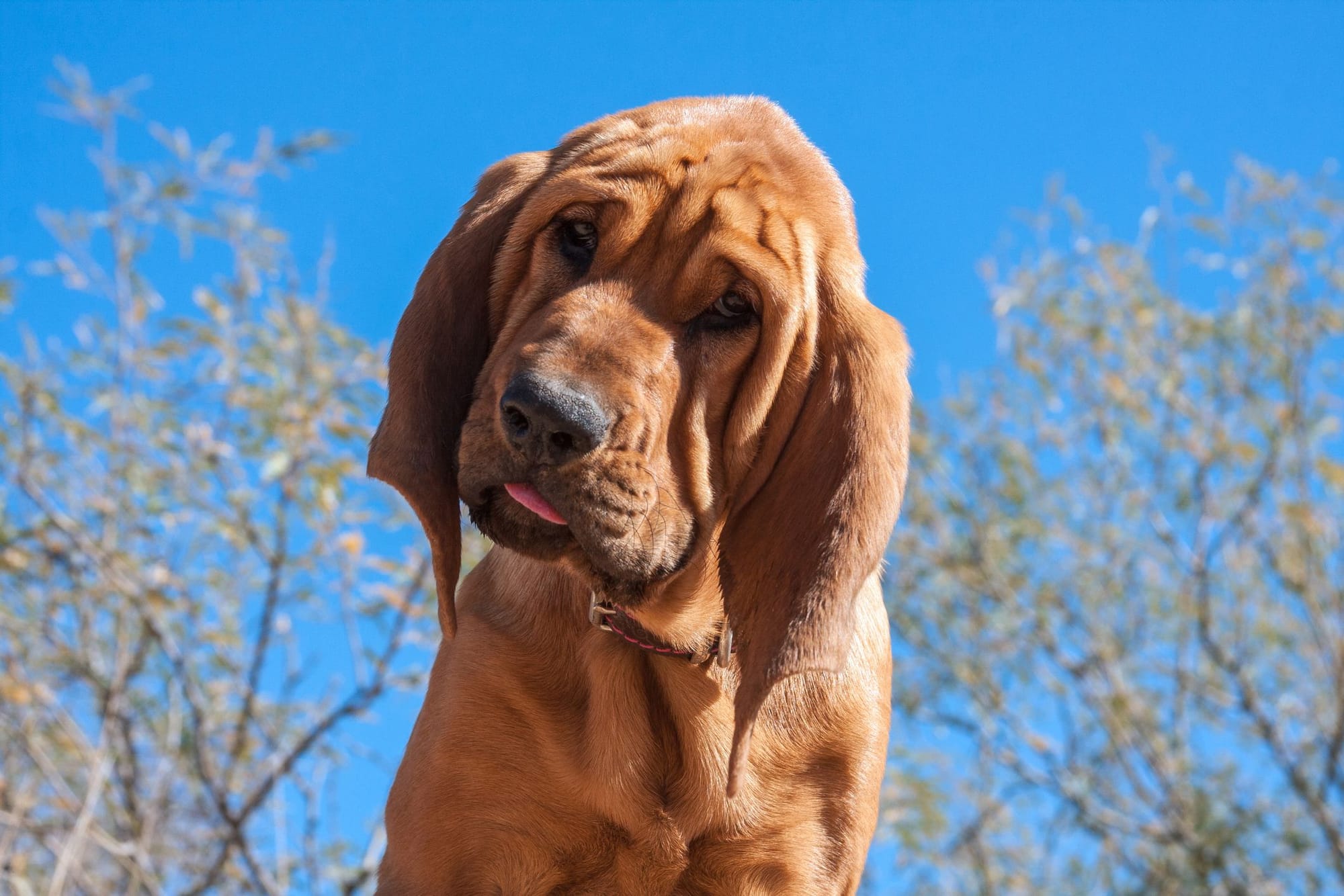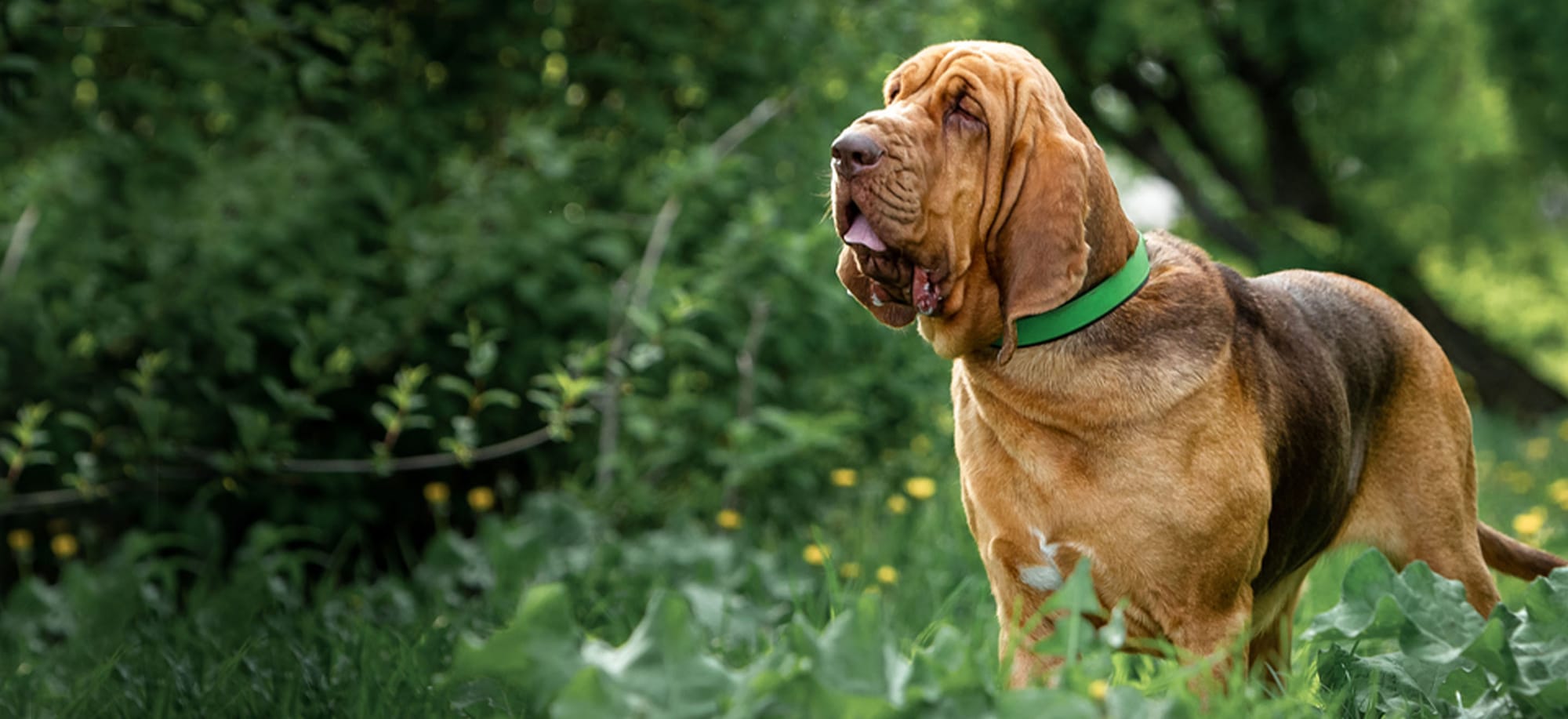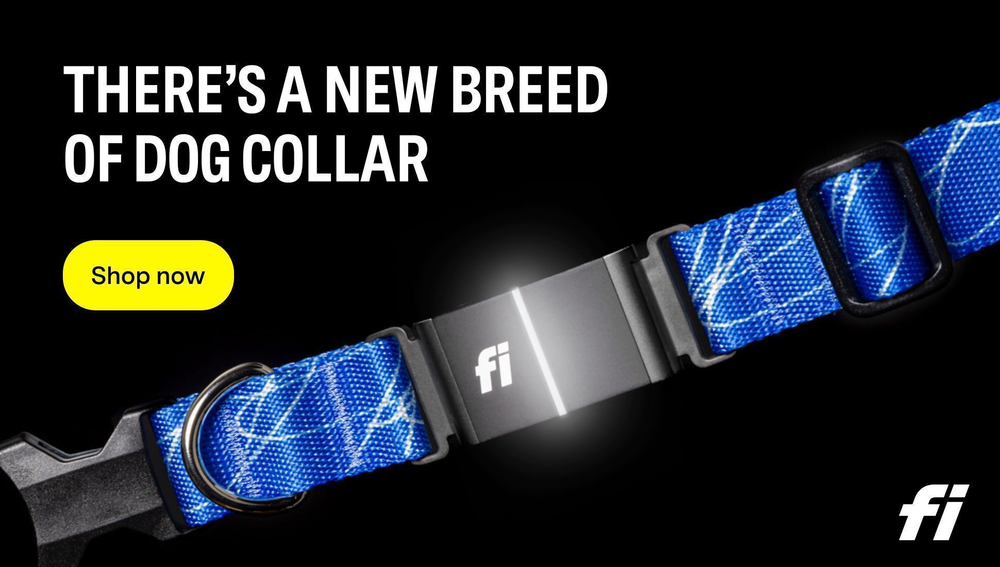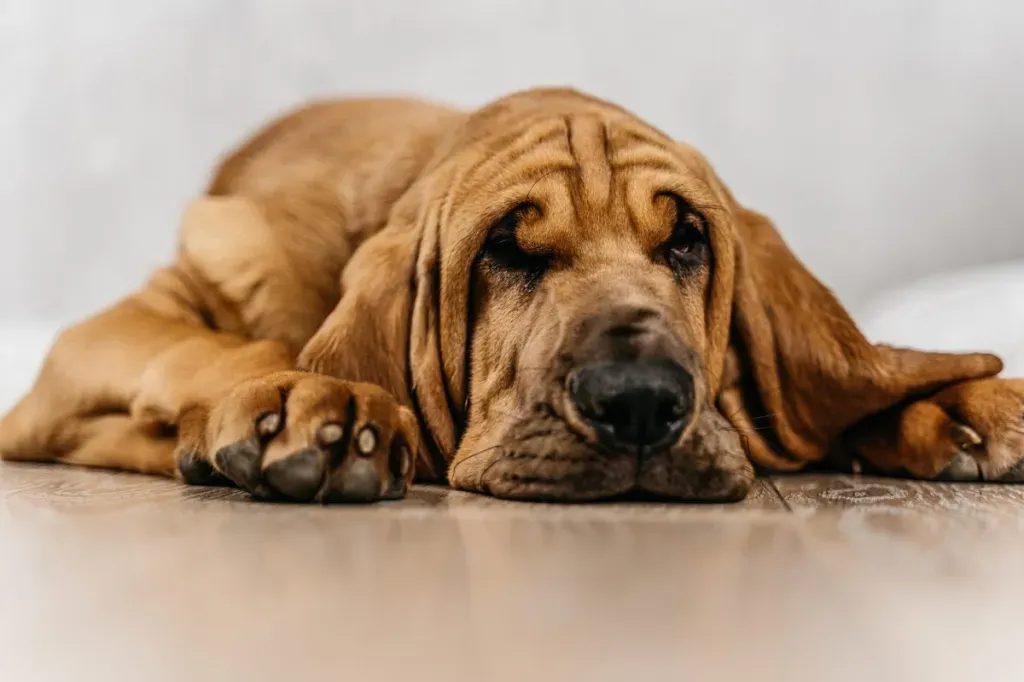Bloodhounds are a distinctive dog breed known for their acute sense of smell and tracking abilities. Recognized by the American Kennel Club (AKC) for their olfactory prowess, they have been used for centuries in search and rescue operations as well as in law enforcement. While their scenting capabilities are legendary, the visual capacities of these dogs are not as celebrated or commonly understood.

Physiologically, bloodhounds have eyes that are functional and capable of sight, but they do not rely on vision as heavily as they do on their sense of smell. Their history and origin as a breed suggest their development was focused on enhancing their sniffing ability to follow trails over long distances. This selective breeding over time means that while they can see, their world is primarily navigated and interpreted through scent.
Overall, bloodhounds can see adequately to interact with their environment, though their vision is not their primary sense. They may not have the same level of visual acuity as some other breeds that rely more heavily on sight for hunting or herding. However, their eyes serve them well enough to complement their extraordinary sense of smell, which is their most vital and defining characteristic.

Physical Characteristics
Bloodhounds are large scent hounds known for their ability to track scents over great distances and difficult terrain. Physical attributes such as coat type, size, and distinctive features, like their profound sense of smell, are key to their role as tracking dogs.
Coat and Colors
Bloodhounds possess a short, dense coat designed to provide protection from harsh conditions while on a trail. Their colors are typically black and tan, liver and tan, or red, often with a small amount of white on the chest, feet, and tip of the tail.
- Colors: Black and Tan, Liver and Tan, Red
- Coat Texture: Short, Dense
Size and Weight
Typically, male Bloodhounds stand between 25 to 27 inches in height and weigh in the range of 90 to 110 pounds. Females are slightly smaller, generally 23 to 25 inches tall and 80 to 100 pounds.
| Sex | Height | Weight |
|---|---|---|
| Male | 25 to 27 inches | 90 to 110 pounds |
| Female | 23 to 25 inches | 80 to 100 pounds |
Distinctive Features
Bloodhounds are renowned for their distinctive features:
- Ears: Their long, drooping ears can reach beyond the length of their muzzle, aiding in the capture of scents.
- Wrinkles: Loose skin is abundant, creating deep wrinkles, especially around the face and neck.
- Eyes: The breed has deep-set eyes with a mournful expression.
- Nose: A Bloodhound's nose is exceptionally powerful and a defining characteristic.
- Muzzle: Their muzzle is long with a large black nose, which is ideal for their tracking work.
- Ears: Long, Drooping
- Skin: Loose, Wrinkly
- Nose: Large, Black, Powerful Sense of Smell
- Eyes: Deep-set, Mournful Expression
- Muzzle: Long
Temperament and Behavior
In understanding Bloodhounds, their temperament and behavior are remarkably consistent, with the breed's personality being inherently gentle and their social behavior directed by a strong affinity for companionship. They exhibit a well-balanced energy level, suitable for various activities.
Personality
Bloodhounds are known for their gentle demeanor and affectionate nature, making them excellent family pets. They typically exhibit a calm and docile personality, which is a distinct characteristic of the breed. Their intelligence, while not always immediately apparent due to moments of perceived stubbornness, is rooted in their strong sense of smell and ability to follow complex scent trails.
Social Behavior
In social settings, Bloodhounds are good with children and other pets, displaying patience and tolerance. They thrive on interaction and can become attached to their human families. As pack animals, they naturally seek company, and isolation can lead to destructive behavior as a result of separation anxiety.
- Tolerance: High, gentle with family members
- Sociability: Prefers company, can be vocal when seeking attention
Energy Level
Bloodhounds possess a moderate to high energy level, requiring regular exercise to maintain their health and happiness. While they may appear docile indoors, they need daily physical stimulation, such as long walks or tracking activities, to satisfy their primal instinct to follow scents.
- Exercise Needs
- Daily walks: Essential
- Mental stimulation: Highly beneficial due to their tracking abilities
Training and Exercise
Bloodhounds are active dogs that require regular exercise and consistent training to maintain their physical and mental health. Acting on their natural instincts and abilities, they excel with activities that cater to their strengths, including scent games and outdoor activities like hiking.
Exercise Needs
Bloodhounds need significant daily exercise to stay healthy and content. These dogs thrive on activities that allow them to use their powerful sense of smell.
- Daily Walks: At least one long walk per day is recommended.
- Outdoor Activities: Engaging in hiking or playtime in a secure area is ideal.
- Scent Trails: Setting up scent trails for them to follow can provide both physical and mental exercise.
Training Techniques
Training a bloodhound can be challenging due to their independent and sometimes stubborn nature. However, they respond well to training techniques that involve:
- Positive Reinforcement: Rewards and praise work better than harsh corrections.
- Consistency: Regular training sessions help establish good behaviors.
- Patience: Given their independent streak, bloodhounds may require extra time to learn commands.
Mental Stimulation
Mental exercise is just as critical as physical activity for this breed. Bloodhounds enjoy using their natural abilities to solve problems and engage in activities such as:
- Nose Work: Games that involve scent discrimination and tracking.
- Puzzle Toys: Food-dispensing toys that challenge them to think creatively.
- Obedience Training: Learning new commands and tricks to keep their minds active.
Health and Care
Maintaining a Bloodhound's health involves regular grooming, awareness of common health issues, and ensuring a proper diet. Attention to these areas ensures the well-being of these pets.

Grooming and Shedding
Bloodhounds require regular grooming to manage their shedding and overall hygiene. Weekly brushing is recommended to remove loose hair and minimize shedding. They have short hair, but their shedding can be significant, particularly during seasonal changes. Bathing should be done once every two to three months, or as needed, using dog-specific shampoo to keep their coat clean without stripping natural oils.
- Bathing: An infrequent schedule prevents skin irritation.
- Drool: Wipe away drool regularly to prevent skin infections around the mouth and neck.
Common Health Issues
Bloodhounds are prone to certain health conditions that owners should monitor for:
- Hip Dysplasia: A genetic condition resulting in malformed hip joints, causing pain or lameness.
- Bloat: Also known as gastric torsion, it can be life-threatening; owners should learn the signs and seek immediate veterinary care.
- Ear Infections: Their long ears require weekly checks and cleaning to prevent infections.
- Overweight: They can easily become overweight, which exacerbates potential health issues, including joint problems.
Regular veterinary checkups are essential to monitor and address these health concerns promptly.
Diet and Nutrition
A balanced diet is crucial for a Bloodhound's health and longevity:
- Protein: High-quality dog food with adequate protein sustains their muscular build.
- Fats: Moderate fat content for energy and to maintain coat health.
- Weight Management: Monitor portion sizes to prevent obesity, which can lead to more severe health issues like joint stress and heart strain.
- Water Availability: Always provide access to fresh water, as Bloodhounds can drool significantly.
Bloodhounds in Work
Bloodhounds excel in tracking due to their acute sense of smell, which makes them invaluable in law enforcement and hunting scenarios.
Tracking Abilities
Bloodhounds possess a highly developed sense of smell that allows them to track a scent trail over long distances and through challenging terrain. Their tracking abilities stem from a combination of olfactory receptors and a strong work ethic. These dogs can follow a scent trail for miles, and their skills are especially vital in locating missing people or tracking suspects.
- Scent Discrimination: Bloodhounds can discern individual human scents even days after they are left.
- Endurance: They have the stamina to track for hours on end without tiring.
Law Enforcement and Hunting
In law enforcement, bloodhounds serve as trackers for police departments and law enforcement agencies. They have earned the moniker ""sleuth hound"" due to their detective-like efficiency in following a trail.
- Police Work: Bloodhounds assist in finding escaped prisoners, searching for evidence, and locating missing individuals.
- Cooperation with Handlers: They are trained to work closely with their handlers to communicate the trail's direction.
During hunting expeditions, these scenthounds are instrumental in tracking game such as wild boar. Their abilities to navigate diverse terrains and maintain a scent trail make them perfect companions for hunters.
- Hunting: Bloodhounds track game with precision, relying on scent rather than sight.
- Collaboration with Hunters: They partner with hunters to increase the likelihood of a successful hunt.
Breed History and Recognition
The Bloodhound's lineage traces back over a thousand years, deeply rooted in Western Europe's history. The breed's development and official recognition mirror its enduring presence and esteemed role in tracking and hunting.
Historical Use
The Bloodhound's origins can be associated with medieval France and Belgium. St. Hubert Hounds, considered the direct ancestors of today's Bloodhounds, were meticulously bred by monks in the St. Hubert Monastery in Belgium, who are reputed to have been hunters themselves. These hounds were highly prized for their tracking abilities. By the time of William the Conqueror, they became well-known in England as sleuth hounds and were used primarily for hunting game due to their keen sense of smell.
Breed Recognition
Recognition of the Bloodhound as a breed began formally with its acceptance into the American Kennel Club (AKC) in the 1880s. It stands as one of the earliest breeds to be registered by the AKC. The Bloodhound has been showcased at the prestigious Westminster Kennel Club Show since its inception, highlighting the breed's status and prominence in the United States.

Living with a Bloodhound
Living with a Bloodhound can be a fulfilling experience, provided that prospective owners create a suitable home environment, understand their compatibility with families, and are aware of the important considerations for ownership.
Home Environment
Bloodhounds are large dogs that require ample space to move about. Owners should ensure that their living space has a securely fenced yard to accommodate the Bloodhound's need for regular exercise and to prevent them from wandering off. The fences should be high and sturdy as Bloodhounds can be surprisingly agile despite their size. Their thin skin makes them more susceptible to injuries, so a safe indoor and outdoor environment is crucial.
- Tips for a Safe Space:
- Indoors: Clear areas of potential chewing hazards.
- Outdoors: Ensure fences are intact and free from sharp objects.
Compatibility with Families
These dogs are known for their affectionate and calm temperament, making them excellent family companions. However, their size and energy level require supervision when interacting with small children. They typically coexist well with other pets, especially when socialized from a young age.
- Family Dynamics:
- They are gentle with children but may unintentionally knock over smaller children due to their size.
- Socialization is key for harmonious living with other pets.
Considerations for Owners
Bloodhound owners must commit to regular exercise routines, as these dogs are prone to digging and chewing when bored or not adequately stimulated. A leash and collar with ID tags are essential for every outing, as their strong tracking instincts may lead them to follow a scent while ignoring calls or commands. Maintaining these dogs off-leash is not recommended unless in a secured, fenced-in area.
- Owner Responsibilities:
- Daily walks or runs are necessary; leash training is vital.
- Mental stimulation through scent games or training exercises helps to prevent destructive behaviors.
Frequently Asked Questions
Bloodhounds are celebrated for their exceptional sense of smell and tracking abilities. Their eyesight, while not as acute as their olfactory prowess, allows them to adequately navigate their surroundings.

- How do bloodhounds utilize their sense of smell for tracking?
- Bloodhounds have an extraordinary olfactory system that allows them to track scents for miles and over several days. They possess about 300 million scent receptors, enabling them to follow even the faintest trails.
- What are common eye conditions found in Bloodhounds?
- Bloodhounds are prone to several eye conditions, such as entropion, ectropion, and cherry eye. Regular veterinary care is essential to manage these issues and maintain their eye health.
- How does a bloodhound's sense of smell compare to that of a human?
- A bloodhound's sense of smell is estimated to be up to 1,000 times more sensitive than that of a human. This powerful ability makes them invaluable in search-and-rescue operations and criminal investigations.
- Are bloodhounds proficient in water-related activities such as swimming?
- Bloodhounds are capable swimmers, though they are not typically known for their love of water. They can learn to swim and may perform well in water-related activities when properly trained.
- What is the average lifespan of a Bloodhound?
- The average lifespan of a Bloodhound is between 10 to 12 years. Proper care, nutrition, and regular veterinary check-ups are essential to help them live a full life.
- Does the Bloodhound's hearing ability complement its tracking skills?
- While their hearing is not as highly developed as their sense of smell, bloodhounds have an acute sense of hearing that aids them in tracking. It helps them detect subtle sounds that may indicate the direction of a person or animal they are tracking.




